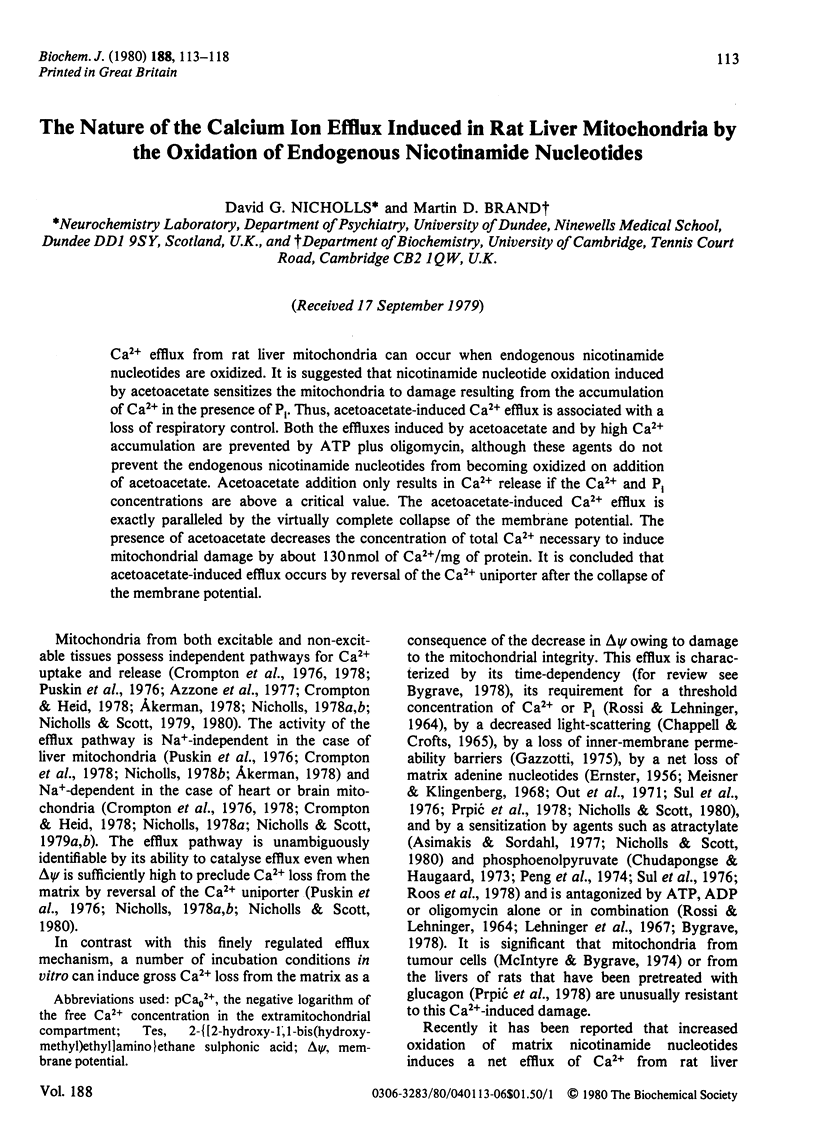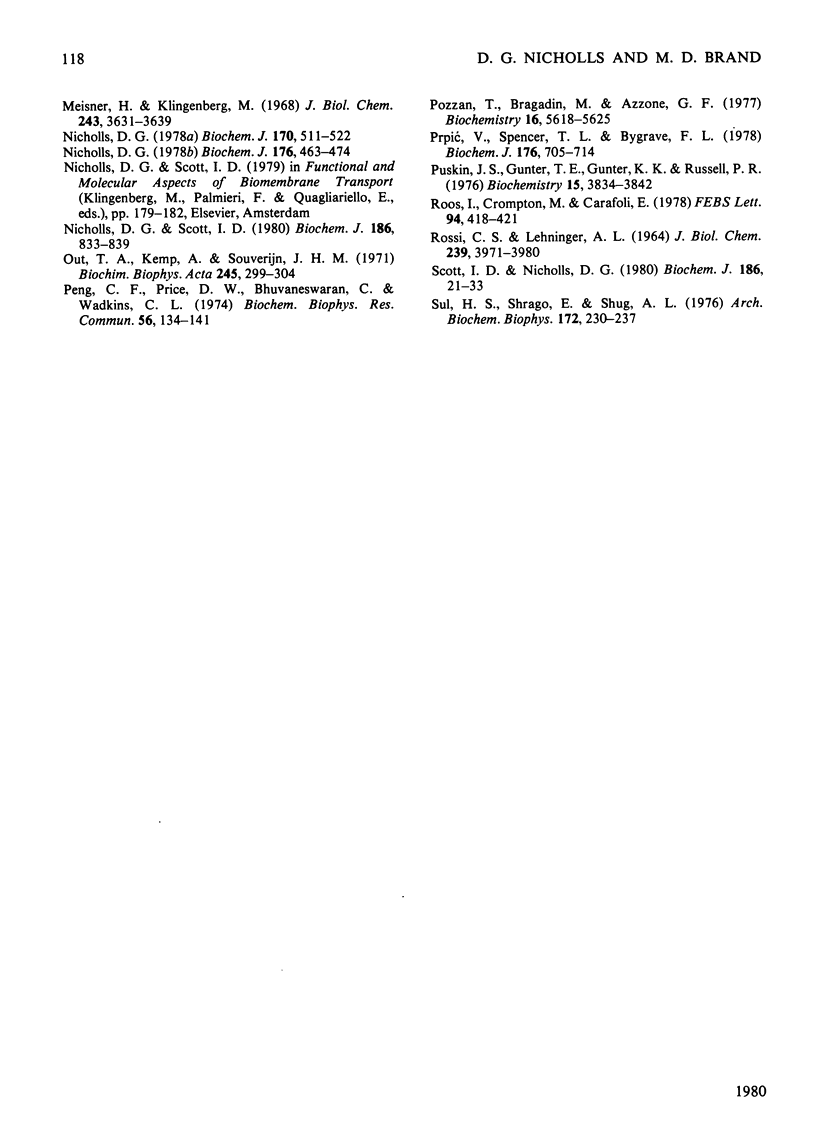Abstract
Ca2+ efflux from rat liver mitochondria can occur when endogenous nicotinamide nucleotides are oxidized. It is suggested that nicotinamide nucleotide induced by acetoacetate sensitizes the mitochondria to damaage resulting from the accumulation of Ca2+ in the presence of Pi. Thus, acetoacetate-induced Ca2+ efflux is associated with a loss of respiratory control. Both the effluxes induced by acetoacetate and by high Ca2+ accumulation are prevented by ATP plus oligomycin, although these agents do not prevent the endoagenous nicotinamide nucleotides from becoming oxidized on addition of acetoacetate. Acetoacetate addition only results in Ca2+ release if the Ca2+ and Pi concentration are above a critical value. The acetoacetate-induced Ca2+ effflux is exactly paralled by the virtually complete collapse of the membrane potential. The presence of acetoacetate decreases the concentration of total Ca2+ necessary to induced mitochondrial damage by about 130 nmol of Ca2+/mg of protein. It is concluded that acetoacetate-induced efflux occurs by reversal of the Ca2+ uniporter after the collapse of the membrane potential.
Full text
PDF





Selected References
These references are in PubMed. This may not be the complete list of references from this article.
- Akerboom T. P., Bookelman H., Zuurendonk P. F., van der Meer R., Tager J. M. Intramitochondrial and extramitochondrial concentrations of adenine nucleotides and inorganic phosphate in isolated hepatocytes from fasted rats. Eur J Biochem. 1978 Mar 15;84(2):413–420. doi: 10.1111/j.1432-1033.1978.tb12182.x. [DOI] [PubMed] [Google Scholar]
- Akerman K. E. Effect of pH and Ca2+ on the retention of Ca2+ by rat liver mitochondria. Arch Biochem Biophys. 1978 Aug;189(2):256–262. doi: 10.1016/0003-9861(78)90211-4. [DOI] [PubMed] [Google Scholar]
- Asimakis G. K., Sordahl L. A. Effects of atractyloside and palmitoyl coenzyme A on calcium transport in cardiac mitochondria. Arch Biochem Biophys. 1977 Feb;179(1):200–210. doi: 10.1016/0003-9861(77)90104-7. [DOI] [PubMed] [Google Scholar]
- Azzone G. F., Pozzan T., Massari S., Bragadin M., Dell'Antone P. H+/site ratio and steady state distribution of divalent cations in mitochondria. FEBS Lett. 1977;78(1):21–24. doi: 10.1016/0014-5793(77)80264-0. [DOI] [PubMed] [Google Scholar]
- Bakeeva L. E., Grinius L. L., Jasaitis A. A., Kuliene V. V., Levitsky D. O., Liberman E. A., Severina I. I., Skulachev V. P. Conversion of biomembrane-produced energy into electric form. II. Intact mitochondria. Biochim Biophys Acta. 1970 Aug 4;216(1):13–21. doi: 10.1016/0005-2728(70)90154-4. [DOI] [PubMed] [Google Scholar]
- Bygrave F. L. Mitochondria and the control of intracellular calcium. Biol Rev Camb Philos Soc. 1978 Feb;53(1):43–79. doi: 10.1111/j.1469-185x.1978.tb00992.x. [DOI] [PubMed] [Google Scholar]
- CROFTS A. R., CHAPPELL J. B. CALCIUM ION ACCUMULATION AND VOLUME CHANGES OF ISOLATED LIVER MITOCHONDRIA. REVERSAL OF CALCIUM ION-INDUCED SWELLING. Biochem J. 1965 May;95:387–392. doi: 10.1042/bj0950387. [DOI] [PMC free article] [PubMed] [Google Scholar]
- Chudapongse P., Haugaard N. The effect of phosphoenolpyruvate on calcium transport by mitochondria. Biochim Biophys Acta. 1973 May 25;307(3):599–606. doi: 10.1016/0005-2736(73)90304-0. [DOI] [PubMed] [Google Scholar]
- Crompton M., Heid I. The cycling of calcium, sodium, and protons across the inner membrane of cardiac mitochondria. Eur J Biochem. 1978 Nov 15;91(2):599–608. doi: 10.1111/j.1432-1033.1978.tb12713.x. [DOI] [PubMed] [Google Scholar]
- Crompton M., Moser R., Lüdi H., Carafoli E. The interrelations between the transport of sodium and calcium in mitochondria of various mammalian tissues. Eur J Biochem. 1978 Jan 2;82(1):25–31. doi: 10.1111/j.1432-1033.1978.tb11993.x. [DOI] [PubMed] [Google Scholar]
- ERNSTER L. Organization of mitochondrial DPN-linked systems. I. Reversible uncoupling of oxidative phosphorylation. Exp Cell Res. 1956 Jun;10(3):704–720. doi: 10.1016/0014-4827(56)90048-9. [DOI] [PubMed] [Google Scholar]
- Fiskum G., Lehninger A. L. Regulated release of Ca2+ from respiring mitochondria by Ca2+/2H+ antiport. J Biol Chem. 1979 Jul 25;254(14):6236–6239. [PubMed] [Google Scholar]
- Gazzotti P. The effect of Ca2+ on the oxidation of exogenous NADH by rat liver mitochondria. Biochem Biophys Res Commun. 1975 Nov 17;67(2):634–638. doi: 10.1016/0006-291x(75)90859-1. [DOI] [PubMed] [Google Scholar]
- Heaton G. M., Nicholls D. G. The calcium conductance of the inner membrane of rat liver mitochondria and the determination of the calcium electrochemical gradient. Biochem J. 1976 Jun 15;156(3):635–646. doi: 10.1042/bj1560635. [DOI] [PMC free article] [PubMed] [Google Scholar]
- Hutson S. M. Steady state kinetics of energy-dependent Ca2+ uptake in rat liver mitochondria. J Biol Chem. 1977 Jul 10;252(13):4539–4545. [PubMed] [Google Scholar]
- Lehninger A. L., Carafoli E., Rossi C. S. Energy-linked ion movements in mitochondrial systems. Adv Enzymol Relat Areas Mol Biol. 1967;29:259–320. doi: 10.1002/9780470122747.ch6. [DOI] [PubMed] [Google Scholar]
- Lehninger A. L. Mitochondria and calcium ion transport. Biochem J. 1970 Sep;119(2):129–138. doi: 10.1042/bj1190129. [DOI] [PMC free article] [PubMed] [Google Scholar]
- Lehninger A. L., Vercesi A., Bababunmi E. A. Regulation of Ca2+ release from mitochondria by the oxidation-reduction state of pyridine nucleotides. Proc Natl Acad Sci U S A. 1978 Apr;75(4):1690–1694. doi: 10.1073/pnas.75.4.1690. [DOI] [PMC free article] [PubMed] [Google Scholar]
- McIntyre H. J., Bygrave F. L. Retention of calcium by mitochondria isolated from Ehrlich ascites tumor cells. Arch Biochem Biophys. 1974 Dec;165(2):744–748. doi: 10.1016/0003-9861(74)90303-8. [DOI] [PubMed] [Google Scholar]
- Meisner H., Klingenberg M. Efflux of adenine nucleotides from rat liver mitochondria. J Biol Chem. 1968 Jul 10;243(13):3631–3639. [PubMed] [Google Scholar]
- Nicholls D. G. Calcium transport and porton electrochemical potential gradient in mitochondria from guinea-pig cerebral cortex and rat heart. Biochem J. 1978 Mar 15;170(3):511–522. doi: 10.1042/bj1700511. [DOI] [PMC free article] [PubMed] [Google Scholar]
- Nicholls D. G., Scott I. D. The regulation of brain mitochondrial calcium-ion transport. The role of ATP in the discrimination between kinetic and membrane-potential-dependent calcium-ion efflux mechanisms. Biochem J. 1980 Mar 15;186(3):833–839. doi: 10.1042/bj1860833. [DOI] [PMC free article] [PubMed] [Google Scholar]
- Nicholls D. G. The regulation of extramitochondrial free calcium ion concentration by rat liver mitochondria. Biochem J. 1978 Nov 15;176(2):463–474. doi: 10.1042/bj1760463. [DOI] [PMC free article] [PubMed] [Google Scholar]
- Out T. A., Kemp A., Jr, Souverijn J. H. The effect of bongkrekic acid on the Ca 2+ -stimulated oxidation in rat-liver mitochondria and its relation to the efflux of intramitochondrial adenine nucleotides. Biochim Biophys Acta. 1971 Sep 7;245(2):299–304. doi: 10.1016/0005-2728(71)90148-4. [DOI] [PubMed] [Google Scholar]
- Peng C. F., Price D. W., Bhuvaneswaran C., Wadkins C. L. Factors that influence phosphoenolpyruvate-induced calcium efflux from rat liver mitochondria. Biochem Biophys Res Commun. 1974 Jan;56(1):134–141. doi: 10.1016/s0006-291x(74)80325-6. [DOI] [PubMed] [Google Scholar]
- Pozzan T., Bragadin M., Azzone G. F. Disequilibrium between steady-state Ca2+ accumulation ratio and membrane potential in mitochondria. Pathway and role of Ca2+ efflux. Biochemistry. 1977 Dec 13;16(25):5618–5625. doi: 10.1021/bi00644a036. [DOI] [PubMed] [Google Scholar]
- Prpić V., Spencer T. L., Bygrave F. L. Stable enhancement of calcium retention in mitochondria isolated from rat liver after the administration of glucagon to the intact animal. Biochem J. 1978 Dec 15;176(3):705–714. doi: 10.1042/bj1760705. [DOI] [PMC free article] [PubMed] [Google Scholar]
- Puskin J. S., Gunter T. E., Gunter K. K., Russell P. R. Evidence for more than one Ca2+ transport mechanism in mitochondria. Biochemistry. 1976 Aug 24;15(17):3834–3842. doi: 10.1021/bi00662a029. [DOI] [PubMed] [Google Scholar]
- ROSSI C. S., LEHNINGER A. L. STOICHIOMETRY OF RESPIRATORY STIMULATION, ACCUMULATION OF CA++ AND PHOSPHATE, AND OXIDATIVE PHOSPHORYLATION IN RAT LIVER MITOCHONDRIA. J Biol Chem. 1964 Nov;239:3971–3980. [PubMed] [Google Scholar]
- Roos I., Crompton M., Carafoli E. The effect of phosphoenolpyruvate on the retention of calcium by liver mitochondria. FEBS Lett. 1978 Oct 15;94(2):418–421. doi: 10.1016/0014-5793(78)80990-9. [DOI] [PubMed] [Google Scholar]
- Scott I. D., Nicholls D. G. Energy transduction in intact synaptosomes. Influence of plasma-membrane depolarization on the respiration and membrane potential of internal mitochondria determined in situ. Biochem J. 1980 Jan 15;186(1):21–33. doi: 10.1042/bj1860021. [DOI] [PMC free article] [PubMed] [Google Scholar]
- Sul H. S., Shrago E., Shug A. L. Relationship of phosphoenolpyruvate transport, acyl coenzyme A inhibition of adenine nucleotide translocase and calcium ion efflux in guinea pig heart mitochondria. Arch Biochem Biophys. 1976 Jan;172(1):230–237. doi: 10.1016/0003-9861(76)90071-0. [DOI] [PubMed] [Google Scholar]


